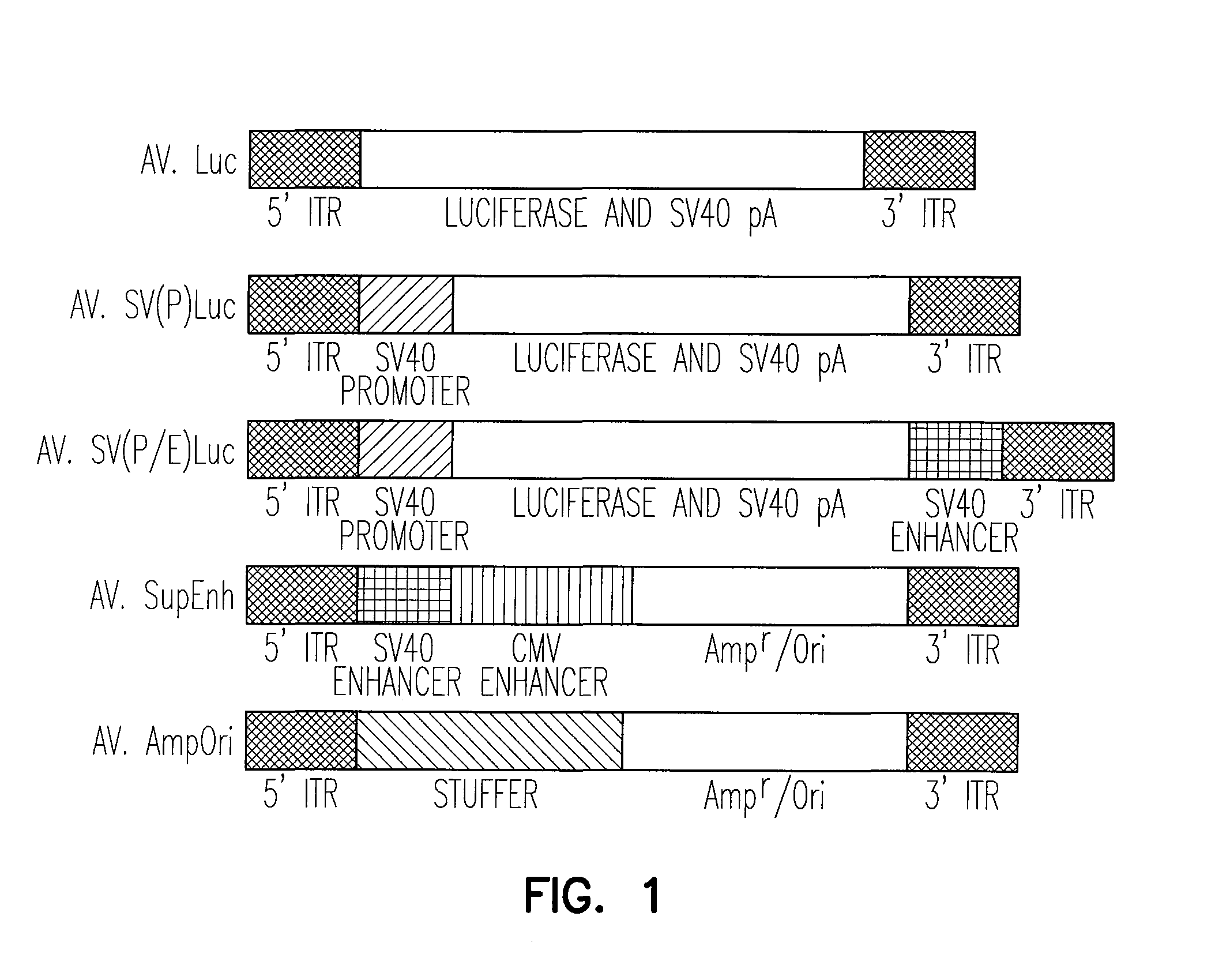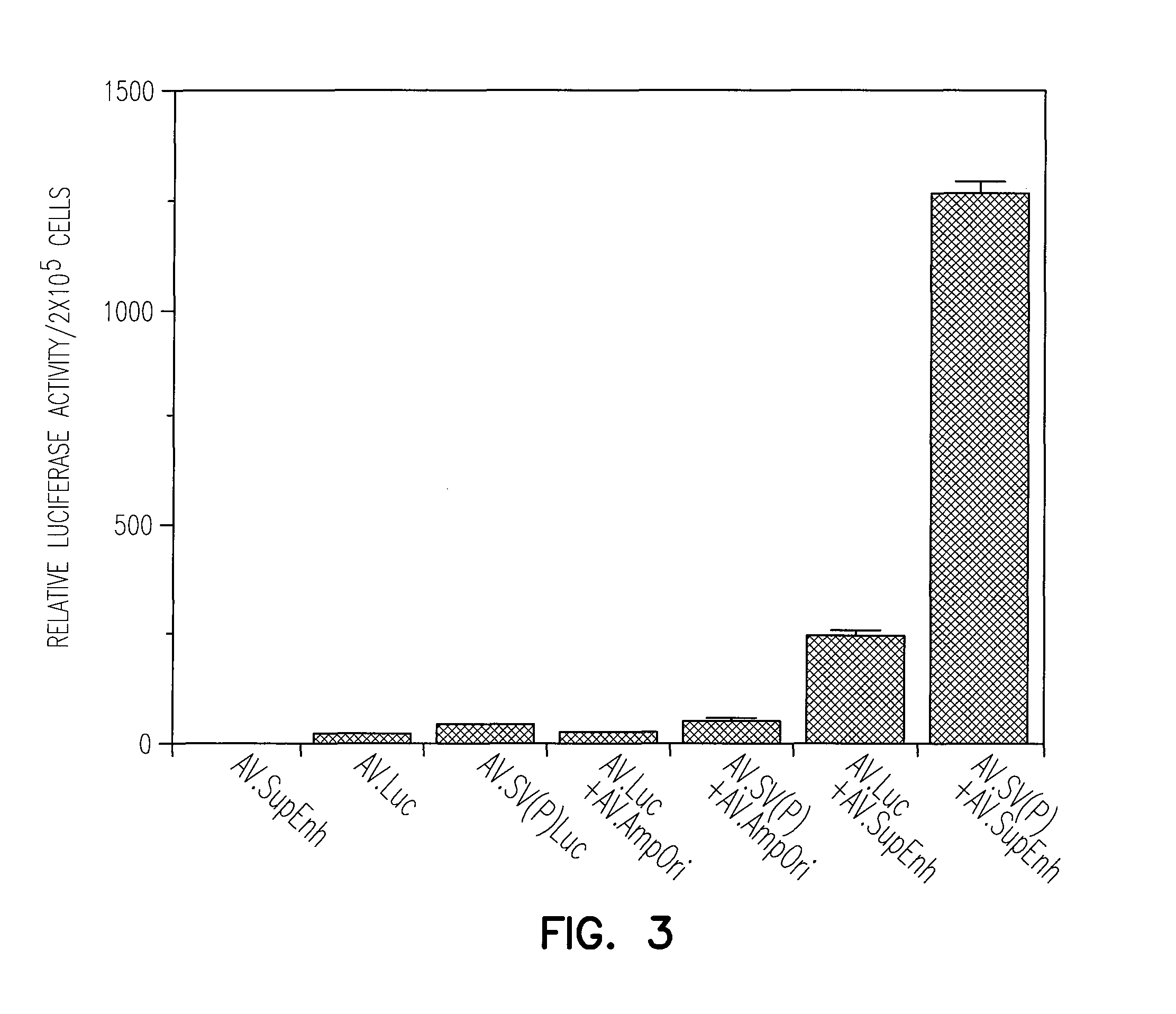Adeno-associated virus vectors with intravector heterologous terminal palindromic sequences
- Summary
- Abstract
- Description
- Claims
- Application Information
AI Technical Summary
Benefits of technology
Problems solved by technology
Method used
Image
Examples
example 1
Enhancement of Recombinant AAV Mediated Gene Expression Through Intermolecular Cis-activation
Materials and Methods
Recombinant AAV vectors
[0145]The pcisAV.Luc proviral plasmid was generated by cloning the 1983 bp NheI / BamHI fragment from pGL3-Basic (Promega), containing the luciferase gene and SV40 late polyA signal, by blunt-end ligation into the blunted XbaI site of pSub201 (Samulski et al., 1987). Similarly, pcisAV.SV(P)Luc was generated using a blunted 2175 bp NheI / BamHI fragment, from the pGL3-Promoter (Promega), containing the SV40 promoter, luciferase gene, and SV40 late polyA signal. The pcisAV.SV(P / E)Luc plasmid was generated by blunt-end ligation of a 2427 bp NheI / SalI fragment from pGL3-Control (Promega) into the blunted XbaI site of psub201. This construct contains the SV40 promoter, luciferase gene, SV40 late polyA signal and SV40 enhancer.
[0146]The “super-enhancer” vector, pcisAV.SupEnh, was produced using a two-step cloning process. First, a 0.62 kb blunted BglII / PvuI ...
example 2
Trans-Splicing Vectors with Intravector Heterologous TPSs
[0159]Engineering dual vector sets with a preferred recombinational bias to form tail-to-head heterodimers is one possible way to overcome the limitation of random recombination that reduces trans-splicing efficiency. Fundamental to such a strategy is a clear delineation of TPS involvement in the recombination process. To approach these questions, two of the most divergent (less than 50% conserved) TPS sequences, i.e., those derived from AAV-2 and AAV-5, were employed to generate a novel intravector heterologous TPS vector genome (AV2:5). This intravector heterologous TPS viral vector contained one AAV-2 TPS and one AAV-5 TPS at either end of the viral genome and functionally transduced a single encoded transgene at a similar efficiency to native rAAV-2 or rAAV-5 vectors, i.e., those with homologous TPSs on both ends. Intravector heterologous AV2:5 TPS viruses were employed to study the involvement of TPS sequences in genome c...
PUM
| Property | Measurement | Unit |
|---|---|---|
| Time | aaaaa | aaaaa |
| Efficiency | aaaaa | aaaaa |
| Therapeutic | aaaaa | aaaaa |
Abstract
Description
Claims
Application Information
 Login to View More
Login to View More - R&D
- Intellectual Property
- Life Sciences
- Materials
- Tech Scout
- Unparalleled Data Quality
- Higher Quality Content
- 60% Fewer Hallucinations
Browse by: Latest US Patents, China's latest patents, Technical Efficacy Thesaurus, Application Domain, Technology Topic, Popular Technical Reports.
© 2025 PatSnap. All rights reserved.Legal|Privacy policy|Modern Slavery Act Transparency Statement|Sitemap|About US| Contact US: help@patsnap.com



